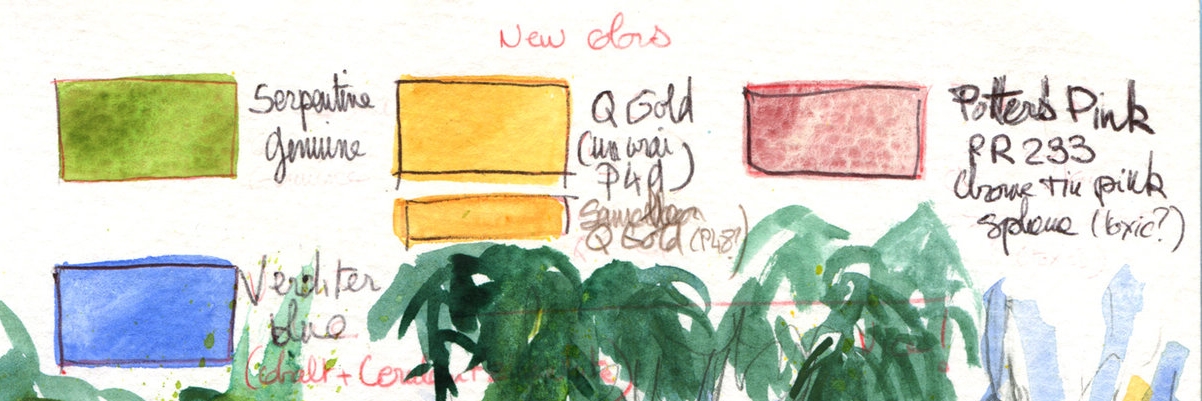About watercolor toxicity.
Because we are around paints since an early age, we don't realize it could be dangerous in the long term. I'm sorry to remind you so: paints are mildly toxic. The kid's ones too are a bit toxic, most of the time. I looked for answers on Crayola Website's, and they clearly state "found to contain no known toxic substances in sufficient quantities to be harmful to the human body". I guess you would need to eat several kilos of crayons to reach a high level of toxicity (and probably die before from the quantity of wax ingested), but the problem is, do the toxic part of paint accumulates in your body? One good idea would be to work with edible paint.
Edible and non toxic paints aren't colorfast. It's not a problem if you don't plan to keep your art. Or if you plan to eat it (no judgement here). It's a big problem if you plan to put your art on a wall.
If you think about it, nobody expects you to eat it, anyway. So the toxicity problem is kind of a blurry area. Watercolor paints have usually a low toxic index, including the ones stating "natural ingredients". Earths like raw Sienna are natural ingredients, but you might not want to eat dirt, right?
Phthalocyanine Blue isn't toxic per se, but " There is some evidence that exposure to phthalocyanines can cause serious birth defects in developing embryos" (read the article here if you are so inclined). True vermilion, a beautiful, opaque red, is a mercury sulfide. And as such, it's toxic. I'm not going to make you the whole list, but while doing my research, I didn't find any pigment that was totally harmless. And even if I was able to find harmless pigments, I will have to consider the adjuvants added to make paint, which involves harmful and less harmful products, including sometimes allergens like dextrin (paint isn't gluten free).
About low toxicity, we're often talking about metal oxides, and some poisonous compounds too, that are present in very low levels in paint. The problem is, if you don't allow time for your body to evacuate them when absorbed, they can accumulate, with possible harmful effects. I couldn't find much about that subject.
I'm not saying you should stop painting. Painting is a lovely activity. Do paint. Most daily activities, from washing hair to walking in the streets, involve dealing with low doses of toxic pollutants, and sometimes ingesting them. I just don't feel like accumulating low risks.
Painting isn't dangerous, as long as you respect a few rules.
1.Don't ingest paint or diluted paint.
It sounds obvious, but I know a lot of artists who lick their brushes to make them pointy. DON'T. Buy nice, elastic brushes that will retain their shape, and if you really have to shape them, use your fingers . I bought a water pot with a small spout. I use the spout to shape my wet brushes in one smooth, rotative movement. Neat!
Also : don't mix up the drink mug and the paint mug. I wrote a post about that, it's half a joke but I'm very serious.
2. Don't use your everyday kitchen items as painting tools.
Buy specific items for painting. If a $1.99 jar or glass as a water pot is all it takes to keep you safe, let there be it, buy one for paint only at the dollar store. And while you're at it, also buy one of those white square ceramic plates : they make fantastic palettes, and wash faster and better than the metal or plastic ones.
3.Use the right water pot.
I bought a small cylindrical glass water pitcher especially for painting. Glass is neutral, non porous, easy to wash. They still use glass for chemical experiments, and actually, a beaker would make a chic, edgy and a bit steampunk waterpot!
4. Dispose of paint and water properly
Perfectly wash your utensils, the sink, etc. I wash my painting utensils in a bathroom, not the kitchen. I make sure not to splash around. I don't wash my stuff in the sink my son uses, and I make sure there's no tooth brush or anything around. This might seems a bit exaggerated, but I paint almost everyday and I'm aware of the accumulative effect of low toxicity.
5. Check the toxicity of the paints you buy.
Better aware than sorry. Dick Blick website is better than most at informing their customers, with little icons near the products to indicate proper use, if there's any toxicity in relation with california prop 65, or if there's a caution label. Read more about it here.
Old cat waking up from a nap in my palette.
6. Protect your pets
If a pet, especially a cat, falls, dips, or naps in your palette, catch her and wash her before she tries to lick it off. Put your chair back under the desk to make it less accessible, and don't fill up your water pot to avoid it becoming a pet bowl.
As a rule, I don't let my cats jump or stay on counters and tables. But cats are cats and the one on the left has been trying for 18 years to declare my tables cat territory, an ongoing war that ended up several times in gooey messes.
7. If you're the kind who ends up covered in paint while painting, wear gloves and an apron.
I can't paint with gloves on, my husband can. But I do wash my hands every time they get stained, and make sure the paint doesn't go under my nails.
And, once you learned about the risks, and took the proper habits... paint your heart content!
Please check the toxicity of your favorite colors : I can't be held responsible if you handle something dangerous without checking the appropriate way to do it.



